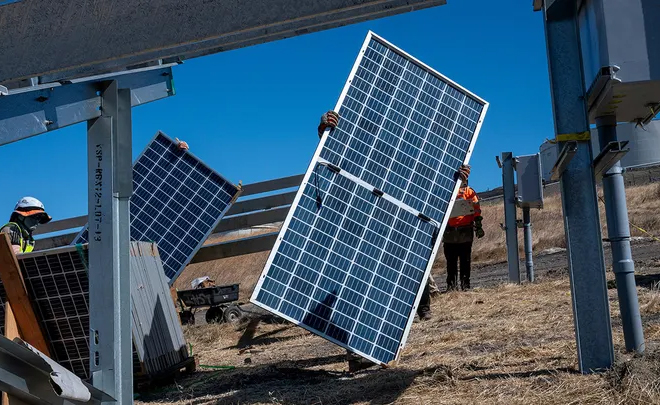According to the "US Solar Market Insights Q3 2024 Report" released today by the Solar Energy Industry Association of America (SEIA) and Wood Mackenzie, as the solar industry installed 9.4 gigawatts of new generation capacity in Q2 2024, federal clean energy policies continue to drive manufacturing and deployment growth.
Within two years of the implementation of the IRA, the solar industry added 75 gigawatts of installed capacity to the grid, accounting for over 36% of the historical solar power generation capacity in the United States. Since the IRA was passed, nearly 1.5 million American households have installed solar energy.
SEIA President and CEO Abigail Ross Hopper said, "The solar and energy storage industry is putting federal clean energy policies into action, rapidly creating job opportunities, and driving economic growth in all 50 states in the United States, especially Arizona, Nevada, and Georgia. We are currently producing a historic high of solar energy in the United States, and soon we will have enough domestic module production to meet almost all of America's demand in the coming years
Texas continues to dominate the solar energy market, with 5.5 gigawatts of solar capacity installed in the first half of 2024, leading the United States. Texas, Florida, Nevada, Ohio, and Arizona, which were highly anticipated in the November elections this year, are all among the top ten states in terms of solar capacity in 2024.
The solar industry performed exceptionally well in the second quarter, mainly due to the growth in the utility scale sector, "said Michelle Davis, Global Head of Solar Energy at Wood Mackenzie and lead author of the report. However, the future growth of solar energy is hindered by broader challenges in the power industry, such as backlogs in interconnectivity, shortages of electrical equipment, and limited labor supply. The industry also faces uncertainty related to newly proposed tariffs and presidential elections. Currently, there are many issues in the solar energy industry that need to be addressed
Affected by policy changes in California and high national interest rates, the residential solar market continued to shrink in the second quarter of 2024. The industry added 1.1 gigawatts of production capacity in the second quarter, the lowest in nearly three years. However, the residential solar energy market is expected to grow again in 2025 and is expected to set an annual record in 2026-2029.
As the solar energy industry addresses the aforementioned challenges, the annual installed capacity of solar energy is expected to increase by an average of 4% in the coming years. By 2029, the total installed solar capacity in the United States is expected to double to 440 gigawatts.
According to the "US Solar Market Insights Q3 2024 Report" released today by the Solar Energy Industry Association of America (SEIA) and Wood Mackenzie, as the solar industry installed 9.4 gigawatts of new generation capacity in Q2 2024, federal clean energy policies continue to drive manufacturing and deployment growth.
Within two years of the implementation of the IRA, the solar industry added 75 gigawatts of installed capacity to the grid, accounting for over 36% of the historical solar power generation capacity in the United States. Since the IRA was passed, nearly 1.5 million American households have installed solar energy.
SEIA President and CEO Abigail Ross Hopper said, "The solar and energy storage industry is putting federal clean energy policies into action, rapidly creating job opportunities, and driving economic growth in all 50 states in the United States, especially Arizona, Nevada, and Georgia. We are currently producing a historic high of solar energy in the United States, and soon we will have enough domestic module production to meet almost all of America's demand in the coming years
Texas continues to dominate the solar energy market, with 5.5 gigawatts of solar capacity installed in the first half of 2024, leading the United States. Texas, Florida, Nevada, Ohio, and Arizona, which were highly anticipated in the November elections this year, are all among the top ten states in terms of solar capacity in 2024.
The solar industry performed exceptionally well in the second quarter, mainly due to the growth in the utility scale sector, "said Michelle Davis, Global Head of Solar Energy at Wood Mackenzie and lead author of the report. However, the future growth of solar energy is hindered by broader challenges in the power industry, such as backlogs in interconnectivity, shortages of electrical equipment, and limited labor supply. The industry also faces uncertainty related to newly proposed tariffs and presidential elections. Currently, there are many issues in the solar energy industry that need to be addressed
Affected by policy changes in California and high national interest rates, the residential solar market continued to shrink in the second quarter of 2024. The industry added 1.1 gigawatts of production capacity in the second quarter, the lowest in nearly three years. However, the residential solar energy market is expected to grow again in 2025 and is expected to set an annual record in 2026-2029.
As the solar energy industry addresses the aforementioned challenges, the annual installed capacity of solar energy is expected to increase by an average of 4% in the coming years. By 2029, the total installed solar capacity in the United States is expected to double to 440 gigawatts.



